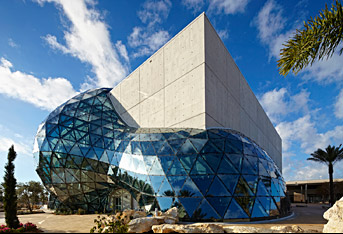Dali Museum Wows with Immersive Art Experience
Tourists Drawn to Dali's Art and Stunning Architecture
Salvador Felipe Jacinto Dali I Domenech, more commonly known as simply Dali, is considered one of the premier artists of the 20th century. His work pushed the boundaries of the possible into the "surreal" and changed the way people perceive art. The public's continued fascination with Dali, and the Surrealist movement he helped inspire, can be seen in the success of the new Dali Museum in St. Petersburg, Florida.
 The east view of the Salvador Dali Museum.
The east view of the Salvador Dali Museum. Photo credit: Kathy White, the Salvador Dali Museum
High-resolution version of this photo.
Since opening on January 11, 2011, nearly a half a million art enthusiasts have walked through the 66,400 square-foot building and exhibit floor. While visitors are certainly coming to view the renowned work of the Spanish painter, they are also getting a chance to admire the museum's breathtaking architecture that was built specifically for the Morse Family collection of Dali art.
Taking its visual cues from Surrealist design, the geodesic dome structure that surrounds the building is referred to as the Enigma and consists of 1,062 unique, triangular glass panels. The design was inspired by Dali and Buckminster Fuller's work on the Teatro Museo in Figueres, Spain, which houses Dali's personal collection, according to Kathy White, deputy director of the Dali Museum.
Of designing the Enigma, architect of the Dali Museum and HOK Tampa Director of Design Yann Weymouth said his team meant to show the influence of Surrealism, without being trite.
"We have elected to do this by taking a page from some of the principles of visual perception he (Dali) exploits," Weymouth said. "The solid, Cartesian, rational rectangular volume of the museum is opposed, disrupted, by the glass Enigma."
The impressive structure is designed to withstand up to a Category 5 hurricane, which is extremely important for a building in Florida which houses such valuable pieces. Precautions were also taken to protect the art from unforeseen hazards inside the building.
"The protection of the displays was a major concern and the design attempted to eliminate a situation where any water piping would be installed above the art," said Jim Stark, vice-president and senior project manager at Feddon Mechanical, the company which installed the plumbing system.
To ensure the artwork would be safeguarded from a possible leak, the museum opted with a mechanical copper system, because of its reliability, proven performance and longevity.
Stark added that the major reason they chose to use the press-connect system, which can be used for most plumbing applications including cold and hot water distribution because its durable, versatile and easy to install, was the time needed to install all 1,500 feet of tubing.
"The project had a critical deadline (the opening was scheduled for 1/11/11) and this joining system can cut labor by 30 percent, allowing the same size crew to install much more pipe in a shorter period of time," he added.
Besides solderless fittings saving time, the joints can be made with water in the tubing, making them ideal for emergency situations and repairs. Unlike soldered and brazed joints, solderless connections do not have to cool and can be pressure-tested immediately after the joint is fabricated. Because flame is not used, burn permits or a "fire watch" are not necessary during installation. More importantly, system modifications can be made without fear of discoloration or damage to nearby building finishes or components. Cu
Also in this Issue:
- 9/11 Memorial – A Look Inside
- Upgrade at Ronald McDonald House Keeps Families Connected
- Dali Museum Wows with Immersive Art Experience
- A New Timepiece for Bradley U.
